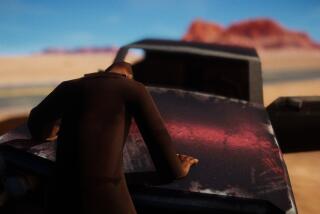Lost in the ‘Myst’
- Share via
An otherwise intelligent and insightful person once described “Myst” as the coffee-table book of video games--meaning one of the most popular computer titles in history was pleasant enough to look at, but really not that deep or compelling.
He, like many who bought the original game, simply wandered around ogling the beautiful scenery, bored by the languid pace and stumped by often-obscure puzzles that made it difficult to progress very far into the rich story that made “Myst” interesting.
“Myst III: Exile” for the PC and Mac offers no relief from that pickle, instead delivering a series of truly painful puzzles wrapped in sumptuous visuals that go nowhere fast. In other words, players who enjoyed “Myst” and its sequel, “Riven,” will love--love--”Exile.” Folks who just didn’t get “Myst” won’t get “Exile” either.
But in this age of ever-faster, ever-noisier games requiring players to eviscerate, decapitate and otherwise inflict mortal harm on their fellow man, “Exile” offers a relaxing, nonviolent respite in which reflection and deliberation are rewarded with a classic tale of suffering and redemption.
Although “Exile” is the first “Myst” adventure not created by brothers Robyn and Rand Miller, it’s virtually impossible to tell. Rand Miller still portrays Atrus, the main character who creates the realms players explore. The lazy pace of the first two games remains. The haunting music mimics the sparse style of “Myst” compositions. The puzzles demand that players pay attention to every excruciating detail of the things they see and hear. Finally, the visuals create fantastic worlds that spring literally from imagination.
The worlds, or ages, of “Myst” are created by Atrus, who writes them down in magical books that contain all the details needed to create and sustain life. Players use the books to link from one age to the next, and it’s the anticipation of what new beautiful imagery lies beyond each twist in the path that drives “Exile” forward.
“Exile” begins 10 years after the events of “Myst” and “Riven.” For those who didn’t finish “Myst,” here’s a spoiler: It was about Atrus’ two sons, who got greedy and sadistic and ultimately were wiped out for playing fast and loose with the worlds their father created.
That’s important to know in “Exile,” which tells the story of one man--Saavedro--who watched his civilization get ruined by Atrus’ sons and then ended up imprisoned by them on a forbidding island designed as a sort of classroom for building new worlds. He seeks revenge on Atrus, and players embark on a quest to confront Saavedro and take back a book he stole.
Along the way, the game whisks players through five entirely new ages--each with its own theme. These thematic connections represent a depth not found in many games and inform everything from the way worlds look to how they function. For instance, Voltaic, the age of energy, is a spartan rock with wires and turbines tucked among the crags and crevices. Every puzzle in this age has to do with power--from hooking it up to harnessing it properly.
These puzzles can send players into a frustrating tailspin. Neither easy nor consistent, they sometimes ask players to think logically and other times to think creatively. Puzzles in Edanna, the age of nature, are particularly difficult--outclassed only by the final world in which players come face to face with Saavedro. The game’s last problem requires the player to have paid attention to a single, subtle tidbit most players probably never even processed.
So tricky are the puzzles that the $50 collector’s edition of “Exile” comes with a strategy guide that, among other things, spells out solutions for the puzzles. True fans should opt for the regular retail version sans strategy guide because the sense of accomplishment that comes from finally cracking some of these brain teasers is truly satisfying.
And it makes the process of discovery that much richer. Like all “Myst” games, “Exile” places a premium on slow-paced exploration. Standing in the pagodas of Amateria, the age of dynamic forces, it’s tempting to just stop and watch the electrical storm brewing over the endlessly undulating sea.
As in other “Myst” games, players move along predetermined pathways. The ages can be completed in any order, but moving from Point A to Point B within them means following set paths in which static images dissolve into each other to create the sense of motion. Unlike the previous games, though, players have the ability to look in every direction around them, giving “Exile” a more realistic feel than “Myst” or “Riven.”
Tiny touches such as gently rolling waves highlight every age. Saavedro’s cluttered desk contains clues tucked among plenty of dead ends. Contraptions sprawl across every inch of some ages, and each tiny component looks like a piece of art.
There are times, however, when beauty overwhelms sensibility. Some of the paths in “Exile”--although exquisitely rendered--are not at all clear, particularly in the Edanna age, which features gnarled roots and dark passages. It’s tough to tell which end is up and whether ground has been covered before. This leads to players madly clicking all over the screen to find the right path.
Overall, though, “Exile” is a worthy successor to “Myst” and “Riven”--and then does those games one better. Read that as you will: as either a temptation or a warning.
*
Aaron Curtiss is editor of Tech Times.
(BEGIN TEXT OF INFOBOX / INFOGRAPHIC)
The Skinny
“Myst III: Exile”
Genre: Adventure/puzzle
Price: $45
Platform: PC/Mac
System requirements: On a PC, a Pentium II 233 with 64 MB of RAM and 200 MB of available hard disk space. On a Mac, 233-MHz G3 processor with 64 MB of RAM and 200 MB of available hard disk space.
Publisher: Ubi Soft Entertainment
ESRB* rating: Everyone
The good: Beautiful environments, challenging puzzles
The bad: Some of the puzzles are just obscure
Bottom line: A worthy successor to “Myst” and “Riven”
*Entertainment Software Ratings Board
More to Read
The biggest entertainment stories
Get our big stories about Hollywood, film, television, music, arts, culture and more right in your inbox as soon as they publish.
You may occasionally receive promotional content from the Los Angeles Times.










